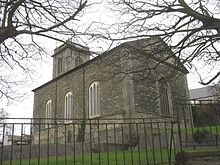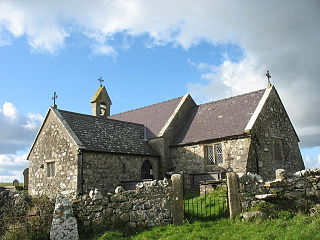
St Peulan's Church, Llanbeulan is a redundant Anglican church in Llanbeulan, in Anglesey, north Wales. The nave, which is the oldest part of the building, dates from the 12th century, with a chancel and side chapel added in the 14th century. The church has a font of early date, possibly from the first half of the 11th century: one historian has said that it would initially have been used as an altar and that "as an altar of the pre-Norman period it is a unique survivor in Wales and, indeed, in Britain".

St Cristiolus's Church, Llangristiolus is a medieval church near the village of Llangristiolus, in Anglesey, north Wales. The village, about 1 mile (1.6 km) from the building, takes its name from the church. Reputedly founded by St Cristiolus in 610, the present building dates from the 12th and 13th centuries. Alterations were made in the 16th century, when the large east window in Perpendicular style was added to the chancel – a window which has been described by one guide to the buildings of north Wales as "almost too big to fit" in the wall. Some restoration work took place in the mid-19th century, when further windows were added and the chancel largely rebuilt.

St Mary's Church, Pentraeth is a small medieval parish church in the village of Pentraeth, in Anglesey, north Wales. The date of construction is unknown, but is probably from some time between the 12th to 14th centuries. A church dedicated to St Mary was recorded here in 1254, but there is a tradition that there was an older church dedicated to St Geraint, an early British saint. Some medieval stonework remains in three walls of the building. A chapel was added to the south side in the 16th or 17th century. The church was altered and refurbished during the 19th century, including an extensive rebuilding by Henry Kennedy, the architect for the Diocese of Bangor, in 1882. St Mary's is still used for worship by the Church in Wales, and is one of three churches in a combined parish. Its conservation is specifically included in the aims of a Chester-based charity that promotes health and the arts in Anglesey and the north-west of England.

St Mary's Church, Bodewryd is a small medieval church in the hamlet of Bodewryd, in Anglesey, north Wales. The date of construction is unknown, but there was a church on this site in 1254 and the earliest feature to which a date can be given is a doorway in a 15th-century style dating to around 1500. When the church was restored in 1867 after being struck by lightning, stained glass with Islamic-influenced patterns was included in the windows, a requirement of Lord Stanley of Alderley, the church's benefactor, who was a convert to Islam.

St Tyfrydog's Church, Llandyfrydog is a small medieval church, in Llandyfrydog, Anglesey, north Wales. The date of establishment of a church on this site is unknown, but one 19th-century Anglesey historian says that it was about 450. The oldest parts of the present building are dated to about 1400, with the chancel dating from the late 15th or early 16th century. It is built from rough, small, squared stones, dressed with limestone. One of the windows on the south side is raised to illuminate the pulpit, a decision that in the eyes of one 19th-century commentator "disfigures the building."

St Ffinan's Church, Llanffinan is a small 19th-century parish church built in the Romanesque revival style, in Anglesey, north Wales. There has been a church in this area, even if not on this precise location, since at least 1254, and 19th-century writers state that St Ffinan established the first church here in the 7th century. The church was rebuilt in 1841, reusing a 12th-century font and 18th-century memorials, as well as the cross at the eastern end of the roof.
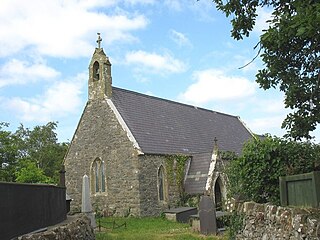
St Deiniol's Church, Llanddaniel Fab, is a small 19th-century parish church in the centre of Llanddaniel Fab, a village in Anglesey, north Wales. The first church in this location is said to have been established by St Deiniol Fab in 616. He was the son of St Deiniol, the first Bishop of Bangor. The current building, which is in Early English style, incorporates some material and fittings from an earlier church on the site, including the font and an 18th-century memorial in the porch. The vestry door has medieval jambs and the keystone of its arch, which is also medieval, is a carved human face. Some parts of the nave walls may also come from a previous building here.
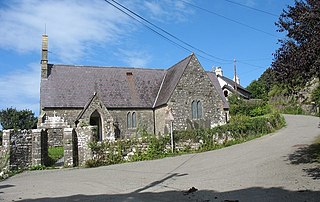
St Dona's Church, Llanddona ) is a small 19th-century parish church in the village of Llanddona, in Anglesey, north Wales. The first church on this site was built in 610. The present building on the site dates from 1873, and was designed by the rector at the time. It reuses earlier material including a decorated 15th-century doorway and a 17th-century bell.

St Caian's Church, Tregaian, also known as St Caean's Church, Tregaean, is a small medieval church dating from the 14th century in Anglesey, north Wales. It is dedicated to St Caian, a Christian from the 5th or 6th century about whom little is known. The building contains a late 14th-century east window and a late 15th-century doorway. The churchyard contains the grave of William ap Howel, who died in 1581 at the age of 105, leaving over forty children between the ages of 8 and 89 and over three hundred living descendants.

St Gallgo's Church, Llanallgo is a small church near the village of Llanallgo, on the east coast of Anglesey, north Wales. The chancel and transepts, which are the oldest features of the present building, date from the late 15th century, but there has been a church on the site since the 6th or early 7th century, making it one of the oldest Christian sites in Anglesey. Some restoration and enlargement took place during the 19th century.

St Gwenllwyfo's Church is a 19th-century parish church near the village of Dulas, in Anglesey, Wales. It was built between 1854 and 1856 to replace an earlier church in the parish, also dedicated to St Gwenllwyfo, which needed repair and had become too small for its congregation. The new church was built nearer to the Llys Dulas estate, whose owner contributed £936 towards the total cost of £1,417, rather than near the area where many of the parishioners lived. In 1876, Sir Arundell Neave donated 27 panels of 15th and 16th-century stained glass that had once belonged to a Flemish monastery.

St Beuno's Church, Trefdraeth is the medieval parish church of Trefdraeth, a hamlet in Anglesey, north Wales. Although one 19th-century historian recorded that the first church on this location was reportedly established in about 616, no part of any 7th-century structure survives; the oldest parts of the present building date are from the 13th century. Alterations were made in subsequent centuries, but few of them during the 19th century, a time when many other churches in Anglesey were rebuilt or were restored.

St Eugrad's Church, Llaneugrad is an isolated church near the village of Marian-glas, in Anglesey, north Wales. A church was supposedly founded here by St Eugrad in about 605, although the earliest parts of the present structure are the nave, chancel and chancel arch, which date from the 12th century. A side chapel was added to the north in the 16th century, and some moderate restoration work was carried out in the 19th century. It contains a 12th-century font, a 13th-century carved stone depicting the crucifixion, and a memorial to one of the officers killed when the Royal Charter sank off Anglesey in 1859.

St Beuno's Church, Aberffraw is a 12th-century parish church in Anglesey, north Wales. A church was established in Aberffraw in the 7th century by St Beuno, who became the abbot of Clynnog Fawr, Gwynedd. St Beuno's may have been used as a royal chapel during the early Middle Ages, as the princes of Gwynedd had a court in Aberffraw. The oldest parts of the church date from the 12th century, although it was considerably enlarged in the 16th century when a second nave was built alongside the existing structure, with the wall in between replaced by an arcade of four arches. Restoration work in 1840 uncovered a 12th-century arch in the west wall, which may have been the original chancel arch or a doorway to a western tower that has been lost. The church also has a 13th-century font, some memorials from the 18th century, and two 18th-century copper collecting shovels.

St Mary's Church, Llanfair-yng-Nghornwy is a medieval parish church in the north-west of Anglesey, north Wales. The date of foundation of the church, which is in the village of Llanfair-yng-Nghornwy, is unknown, but the oldest parts date from the 11th or 12th century. It has twice been enlarged: in the 15th century, when the chancel was rebuilt, and in the 16th century, when a chapel was added to the south of the chancel, separated by three arches. The tower at the west end is from the 17th century. A south porch of unknown date has been converted into a vestry, and the church is now entered through the tower.
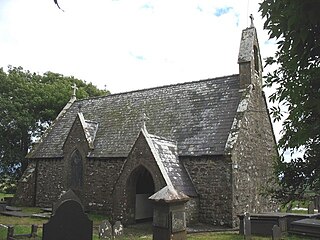
St Cynfarwy's Church is a medieval parish church in Llechgynfarwy, Anglesey, north Wales. The first church in the vicinity was established by St Cynfarwy in about 630, but no structure from that time survives. The present building contains a 12th-century baptismal font, indicating the presence of a church at that time, although extensive rebuilding in 1867 removed the datable features of the previous edifice.

St Edwen's Church, Llanedwen, is a 19th-century parish church near the Menai Strait, in Anglesey, north Wales. The first church was founded here by St. Edwen in 640, but the present structure dates from 1856 and was designed by Henry Kennedy, the architect of the Diocese of Bangor. It contains some memorials from the 17th and 18th centuries and a reading desk that reuses panel work from the 14th and 17th centuries. The 18th-century historian Henry Rowlands was vicar here, and is buried in the churchyard. The church is on land that forms part of the Plas Newydd estate, home of the family of the Marquess of Anglesey since 1812 and owned by the National Trust. Some of the Marquesses of Anglesey, and some of their employees, are also buried in the churchyard.

St Ceinwen's Church, Cerrigceinwen, is a former parish church in the countryside of central Anglesey, north Wales. The present building dates from 1860, although the site has been used for worship since at least the 7th century. The doorway reuses some old carved gravestones, one from the 9th to 11th centuries, and another from the 12th century. The church grounds contain a well, once thought to have healing properties. The church and the well are both named after St Ceinwen, an early Celtic female saint.

St Peter's Church, Llanbedrgoch, is a small medieval parish church near the village of Llanbedrgoch in Anglesey, north Wales. The oldest parts of the building date from the 15th century; it was extended in the 17th century and restored twice in the 19th century. The doorway is decorated with carvings of two human heads, one wearing a mitre. The church contains a reading desk made from 15th-century bench ends, one carved with a mermaid holding a mirror and comb.

St Mihangel's Church in the village of Llanfihangel yn Nhowyn is a former parish church now used as the chapel for RAF Valley in Anglesey, north Wales. The date of the first church on the site is uncertain, but in 1862 the then-existing church was rebuilt. St Mihangel's became the chapel for the nearby Royal Air Force base in 1998, after the Church in Wales had ceased using it for services. It was then extended by dismantling and reassembling another Anglesey church, St Enghenedl's, at the west end of the building.
